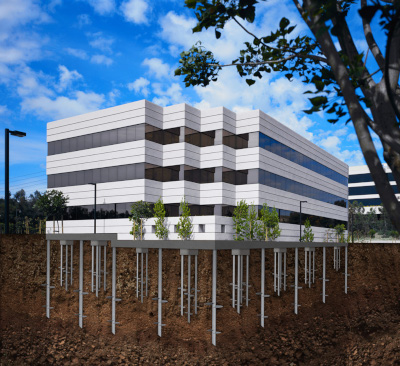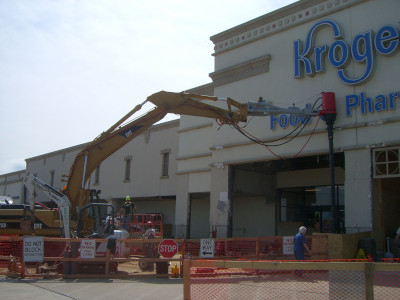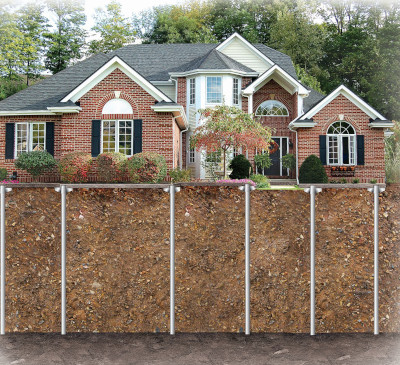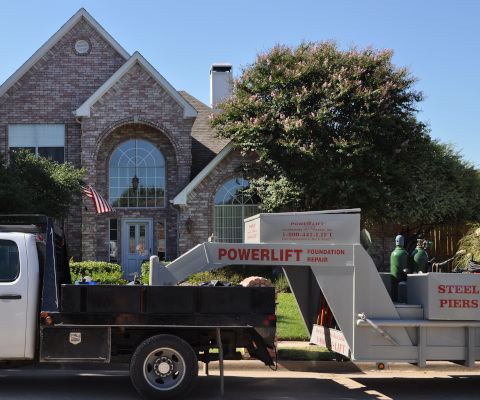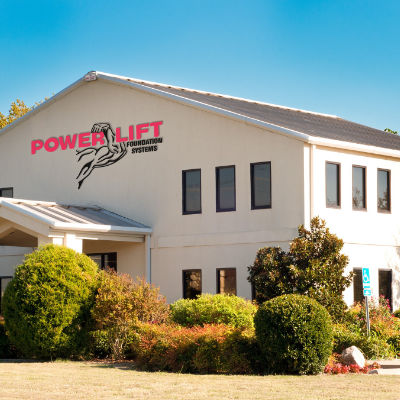Drainage Correction and Waterproofing
Did you know that improper and insufficient storm water removal can cause movement of your home’s foundation?
This movement is generally the result of excess moisture being absorbed by the expansive clay soil. As the moisture is absorbed, volumetric expansion of the clay occurs which produces a swell force that can easily cause a foundation to move upward. In the industry, we refer to this type of soil movement as “heave”.
In most cases, heave is usually caused by the following:
- Poor or improper drainage around the foundation
- Plumbing leaks beneath the foundation
- Moisture present from springs or other underground sources
- Over-watering or improper irrigation
Power Lift solves such foundation issues by implementing one of the followling.
- Landscape grades should be kept a minimum of four (4”) inches below the top of the finished floor on the main level — and should slope away from the foundation at a minimum of one (1”) inch per foot for six (6’) feet. Use moderately plastic clayey soil to fill in areas needed to maintain these grades — sand and topsoil should be avoided. In addition, re-cutting or regrading of the area around the foundation is often necessary. The goal is to promote rapid dissipation of storm water away from the foundation. In some cases, inadequate elevation changes around the structure make water discharge via conventional methods impossible. For problems such as these, a below grade water collection and dispersing system will be required.
- For problems with insufficient fall, a better option to regrading is to design and install a below grade water collection system. This system should be non-perforated, and should collect all of the water being discharged from the downspouts. As well, inlets should be positioned in low areas to collect water trapped near the foundation. If it is determined that subsurface moisture is flowing and accumulating near the foundation, an aggregate incased perforated drain system is often required. This type of system is sometimes referred to as a “French drain”. Frequently, systems such as these will require a collection basin and sump pump to adequately discharge the collected water. Also, it is imperative that perforated drain lines not be used to collect transport surface or storm water from gutters.
But what if water is infiltrating your basement? Lucky for you, Power Lift offers several solutions to fix this problem.
- If cracks are present in the basement walls, Power Lift will often inject a urethane sealer into the cracks to prevent water from entering through walls.
- Should water appear to be entering between the basement floor and wall, a water collection system would be constructed below the interior slab adjacent to the basement wall. This will allow water to be collected before it surfaces in the basement. Once collected, it will be discharged to a collection basin and sump pump.
- If water penetration into the basement continues, the only solution will be to excavate the perimeter foundation and install an exterior water proofing system. This exterior system will first require water blasting to clean the exterior basement wall from all debris. Next, a bonding mastic will be applied to the exterior basement wall surface. A rubberized water proofing membrane will next be applied to the mastic. A corrugated non perforated drainage mat with a geotextile filter will next be placed atop the rubberized membrane. A termination strip will be installed along the top of the water proofing components and sealed with a silicone based sealant. The final step of the system installation will be to install an aggregate incased perforated drain system that discharges into a collection basin and sump pump. The sump pump will be float activated and equipped with a secondary battery backup pump.
- If leakage below the foundation is suspected a complete and thorough test of the plumbing system will be required. It should be noted that any localized leakage of the plumbing system can cause foundation movement regardless of how minute the leak may be. All too often minor leaks are written off as inconsequential. Regardless of the size, no leak should be left below the foundation. For the greatest chance of identifying any leakage from the plumbing system, we recommend that you instruct your plumbing professional to follow the attached testing guidelines. (add plumbing test procedures link here)
- Overwatering or improper irrigation often leads to unwanted foundation movement. Irrigation systems should be routinely monitored to insure adequate uniform delivery of water around your home. Pay particular attention to areas that appear to flood or receive more water than others. Adjust the duration and water output accordingly. Also, pay attention to soft areas where water is surfacing which may indicate the presence of a leak in the irrigation system.
If poor water drainage or water infiltration is wreaking havoc on your home’s structural integrity – Power Lift has a number of solutions at the ready!

